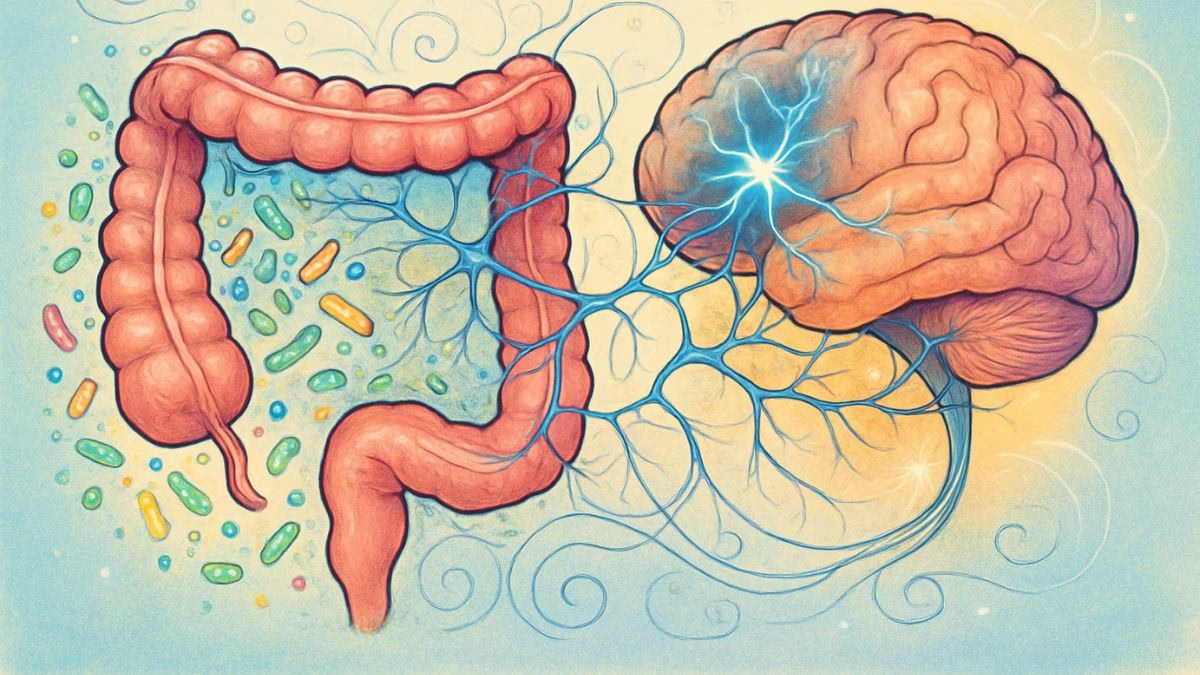Audio Article
For centuries, we’ve used the language of the gut to describe our deepest emotions. We speak of “gut feelings” and “butterflies in the stomach.” We make “gutsy” decisions and feel “sick to our stomach” with worry. This wasn’t just poetic license; it was a profound, almost primal intuition. We’ve always known, on some level, that our bellies and our brains were in conversation. What we’re only just beginning to understand is the sheer depth, complexity, and importance of that dialogue. It turns out, the chatter between your gut and your head isn’t a monologue; it’s a bustling, two-way superhighway of information that powerfully shapes your mood, your thoughts, and your mental health.
Welcome to the cutting-edge science of the gut-brain axis, a field so revolutionary it’s forcing us to rethink the very nature of health, both mental and physical. The star of this story isn’t a newly discovered organ or a miracle molecule. It’s the trillions of microscopic tenants living inside your digestive tract: your gut microbiome. This teeming, sentient ecosystem of bacteria, viruses, and fungi—which collectively weighs about as much as your brain—isn’t just a passive bystander in digestion. It is an active, influential partner in your well-being, acting as a tiny chemical factory that manufactures compounds that can directly influence how you think and feel.
The notion that the bacteria in our gut could be pulling the strings on our anxiety levels or cognitive clarity might sound like science fiction. But the evidence is mounting, and it is compelling. This is not about blaming your bad mood on last night’s pizza (though that might play a part). It’s about a radical paradigm shift in our understanding of the human body: we are not solitary beings, but superorganisms, walking, talking ecosystems whose health is inextricably linked to the health of the microbes within us. Get ready to meet your inner roommates; they have a lot to say.
The Second Brain: A Superhighway of Communication
Before we even get to the microbes, it’s crucial to understand that your gut is, in and of itself, a remarkably intelligent place. Scientists often refer to the gut’s own nervous system—the enteric nervous system (ENS)—as the “second brain.” This intricate network, composed of hundreds of millions of neurons, is so complex that it can operate independently of the brain in your head. It manages the complex dance of digestion, but its job doesn’t stop there.
The two brains are connected by a massive bi-directional pathway called the vagus nerve. Think of it as a fiber-optic cable running from the brainstem down to the abdomen, transmitting a constant stream of messages in both directions. Intriguingly, scientists have discovered that the vast majority—somewhere between 80-90%—of the signals transmitted along this nerve are traveling from the gut to the brain, not the other way around. Your gut is constantly sending status updates to your head, reporting on everything from the nutrients you’re absorbing to the level of inflammation it’s detecting. This is the physiological basis of that “gut feeling”—it’s a real, data-driven signal from your second brain.
The Chemical Messengers: Neurotransmitters
Here’s where things get truly astonishing. Your gut—and more specifically, the bacteria living in it—is a prolific factory for neurotransmitters, the very same chemical messengers that your brain uses to regulate mood. Take serotonin, for example. This is the “feel-good” neurotransmitter, famously associated with feelings of happiness and well-being. It’s the primary target of many antidepressant medications (SSRIs). Where is most of your body’s serotonin produced? Not in your brain. An estimated 90% of it is manufactured in your gut.
The gut microbiome plays a direct role in this process. Certain species of gut bacteria can stimulate the gut cells to produce serotonin or even produce it themselves. The same goes for other critical neurotransmitters like dopamine (related to reward and motivation) and GABA (which has a calming, anti-anxiety effect). A gut that is out of balance, a state known as dysbiosis, may have a diminished capacity to produce these crucial mood-regulating chemicals, creating a shortfall that is felt directly by the brain.
Meet Your Microbiome: The Good, The Bad, and The Crucial
So, who are these microbial puppet masters? Your gut microbiome is a diverse community of trillions of microorganisms. In a healthy state, it exists in a symbiotic relationship with you, its host. You provide them with a warm, nutrient-rich place to live, and in return, they perform a myriad of functions that are vital to your health. They help you digest food, synthesize vitamins, and, crucially, they train and regulate your immune system.
The key to a healthy microbiome isn’t about eradicating “bad” bacteria, but about cultivating a rich and diverse ecosystem where beneficial microbes flourish and keep the more opportunistic, pro-inflammatory ones in check. Think of it like a rainforest. A healthy rainforest is a biodiverse wonderland with countless species of plants, animals, and insects all living in a complex, balanced harmony. A clear-cut forest, on the other hand, is a barren wasteland, susceptible to disease and unable to support life. Your gut is no different.
Dysbiosis: When the Ecosystem is Unbalanced
When this delicate ecosystem is thrown out of whack—due to factors like a poor diet, chronic stress, a round of antibiotics, or illness—it leads to dysbiosis. The “weeds” (the pro-inflammatory bacteria) start to outgrow the “flowers” (the beneficial bacteria). This imbalance can have a cascade of negative effects.
One of the most significant is increased intestinal permeability, often referred to as “leaky gut.” The lining of your gut is supposed to be a tightly controlled barrier, allowing nutrients to pass through while keeping toxins and undigested food particles out. In a state of dysbiosis, the junctions between the gut cells can become loose, allowing inflammatory molecules to “leak” into the bloodstream. When your immune system detects these foreign invaders, it mounts an inflammatory response. This low-grade, chronic inflammation is now understood to be a major contributing factor to a host of modern ailments, including, significantly, depression and anxiety. The brain interprets this systemic inflammation as a sign of sickness, which can manifest as fatigue, social withdrawal, and a depressed mood—a state often called “sickness behavior.”
Eating for Your Ecosystem: A User’s Guide to a Happy Gut
If our gut microbes are so influential, the next logical question is: can we change them? The answer is a resounding yes. Your microbiome is remarkably dynamic and responsive to your lifestyle, especially your diet. The food you eat is not just feeding you; it is directly feeding the trillions of microbes in your gut, and what you choose to put on your plate can either foster a vibrant rainforest or a barren wasteland.
This isn’t about a restrictive, complicated diet. It’s about following a few simple, powerful principles to nourish your microbial allies.
Feed the Good Guys: The Power of Prebiotics
The heroes of your inner ecosystem, the beneficial bacteria, have a favorite food: fiber. Specifically, a type of fiber known as prebiotics. Prebiotics are non-digestible fibers that pass through your small intestine and arrive in your colon intact, where they become a feast for your good gut bugs. When these bacteria ferment prebiotic fiber, they produce incredibly beneficial compounds called short-chain fatty acids (SCFAs), like butyrate.
These SCFAs are superstars of the gut-brain axis. They are the primary energy source for the cells lining your colon, helping to keep the gut barrier strong and healthy. They have powerful anti-inflammatory effects throughout the body. And, amazingly, they can cross the blood-brain barrier and directly influence brain function, promoting the production of BDNF (Brain-Derived Neurotrophic Factor), the “Miracle-Gro for the brain” that supports learning and memory.
- What to Eat: Think diversity. Aim for a wide variety of plant foods. Excellent sources of prebiotics include garlic, onions, leeks, asparagus, bananas (especially slightly green ones), chicory root, Jerusalem artichokes, and whole grains like oats and barley. The simple mantra? Eat more plants.
Reseed the Garden: The Benefit of Probiotics
If prebiotics are the fertilizer, probiotics are the seeds. Probiotics are live, beneficial bacteria that you can consume to help populate your gut with helpful microbes. They are found in fermented foods, where bacteria have been used to preserve and transform the food. Consuming these foods can introduce beneficial species to your gut, helping to crowd out less desirable ones and increase the overall diversity of your microbiome.
- What to Eat: Fermented foods are a cornerstone of traditional diets around the world for a reason. Incorporate foods like plain yogurt (with live and active cultures), kefir (a fermented milk drink), sauerkraut (fermented cabbage), kimchi (a spicy Korean fermented vegetable dish), miso, and tempeh. A small amount of these probiotic-rich foods on a regular basis can make a big difference.
Ditch the Villains: What to Limit
Just as you can feed the good guys, you can also preferentially feed the more inflammatory microbes. The typical Western diet, high in ultra-processed foods, sugar, and unhealthy fats, is like pouring gasoline on an inflammatory fire. These foods provide little to no fiber for the good bacteria, essentially starving them, while providing ample fuel for the pro-inflammatory “weeds” to take over. Artificial sweeteners have also been shown in some studies to negatively alter the gut microbiome.
- What to Limit: Reduce your intake of sugary snacks and drinks, refined carbohydrates (like white bread and pastries), and foods high in processed vegetable oils. You don’t have to be perfect, but shifting the balance of your diet away from these foods and towards whole, plant-based foods is the single most powerful step you can take for your gut and brain health.
The science of the gut-brain axis is still in its nascent stages, a thrilling new frontier in human health. But the foundational message is clear and empowering. We have a powerful, tangible way to influence our mental well-being from the inside out. By becoming conscious caretakers of our inner ecosystem, we are not just improving our digestion; we are nurturing the very foundation of our thoughts, our emotions, and our experience of the world. It’s a profound partnership, and the conversation is just getting started.
MagTalk Discussion
Focus on Language
Vocabulary and Speaking
So, let’s zoom in on some of the words that brought that article to life. Language is a fascinating tool, and sometimes a single, well-chosen word can completely change the way you understand an idea. We’re going to explore some of these words as living concepts you can use in your own conversations. Let’s kick things off with paradigm shift. In the introduction, I called the new understanding of the gut-brain axis a “radical paradigm shift.” A paradigm is a typical example, pattern, or model of something. It’s the accepted way of thinking about a topic. A paradigm shift, then, is a fundamental change in that approach or in the underlying assumptions. For centuries, the paradigm for mental health was that it was all in the head. The idea that gut bacteria could be involved is a massive paradigm shift. The invention of the internet caused a paradigm shift in how we access information. The move from a belief that the sun revolved around the earth to the earth revolving around the sun was a monumental paradigm shift in science. It’s a powerful phrase you use to describe a change that turns the old way of thinking completely on its head.
Next, let’s look at the word symbiotic. I described the relationship between us and our gut microbes as a “symbiotic relationship.” Symbiosis comes from Greek words meaning ‘living together.’ In biology, it describes a close and long-term interaction between two different biological species. A symbiotic relationship is often, but not always, mutually beneficial. The relationship with our gut bacteria is a perfect example of mutualism: we give them a home, and they help us digest food and regulate our immune system. It’s a win-win. You can use this word metaphorically to describe any relationship where two different entities benefit from each other. You might say there is a symbiotic relationship between a local coffee shop and the artists who display their work there. The shop gets free decor, and the artists get exposure. It’s a great word to describe a mutually beneficial partnership.
Let’s unpack the word profound. I used this to describe the intuition that our gut and brain are linked, calling it a “profound, almost primal intuition.” Profound means very great, intense, or deep. It’s a word that signals something is not superficial; it has depth and significance. A profound impact is one that creates a major, lasting change. A profound book is one that makes you think deeply about important issues. Using the word “profound” tells your listener that you’re talking about something of great importance. It has more weight and seriousness than just saying “very big” or “really important.” For example, “Losing a loved one can have a profound effect on a person’s life.”
Now, let’s talk about the word prolific. In the article, I described the gut as a “prolific factory for neurotransmitters.” Prolific means producing a great number or quantity of something. A prolific writer is one who has published many books. A prolific artist has created a huge body of work. A rabbit is a famously prolific animal. When I say the gut is a prolific factory, I’m emphasizing the sheer volume and abundance of the neurotransmitters it produces. It’s not just making a little bit of serotonin; it’s churning out a huge amount. It’s a fantastic adjective to use when you want to convey a sense of great abundance and productivity.
Let’s look at the word nascent. I said that the science of the gut-brain axis is in its “nascent stages.” Nascent means just coming into existence and beginning to display signs of future potential. It describes something that is new, emerging, and still developing. Think of a nascent democracy, a nascent technology, or a nascent social movement. The word carries a sense of excitement and potential, but also an acknowledgment that it’s not yet fully formed. It’s a more sophisticated way of saying “new” or “in its early days.” For example, “The company is a leader in a nascent industry that is expected to grow exponentially.”
Now for a slightly unusual but wonderful word: sentient. I called the microbiome a “teeming, sentient ecosystem.” Sentient means able to perceive or feel things. Humans are sentient beings. Most people would agree that animals are sentient. The word implies a level of consciousness or awareness. Calling a microbial ecosystem sentient is, of course, a bit of a metaphor. The bacteria aren’t ‘thinking’ in the way we do. But I used the word to convey the idea that this ecosystem is not just a passive collection of germs. It is an active, responsive system that perceives its environment (the food you eat, the stress you’re under) and reacts to it in a way that affects you. It’s a word that brings the microbiome to life, framing it as an active participant rather than just inert matter.
Let’s consider the word rudimentary. This word wasn’t in the final draft, but it’s a great one to have. Rudimentary means involving or limited to basic principles. It describes something that is simple, undeveloped, or in its earliest form. You might say you have a rudimentary understanding of physics, meaning you only know the very basics. An early computer was a rudimentary device compared to the smartphones we have today. It’s a good word for describing a starting point or something that lacks sophistication. It’s not necessarily negative; it just means basic.
Next up, the very useful word ubiquitous. This also wasn’t in the article, but it’s relevant to many topics. If something is ubiquitous, it seems to be everywhere at once. It’s omnipresent. In the modern world, plastic is a ubiquitous material. The influence of social media has become ubiquitous. It’s a more formal and powerful word than “common” or “everywhere.” When you say something is ubiquitous, you’re emphasizing its pervasiveness, the feeling that you can’t escape it. For instance, “In a major city, the sound of traffic is ubiquitous.”
Let’s look at the word ecosystem. We used this word to describe the microbiome: a “teeming, sentient ecosystem.” In biology, an ecosystem is a community of living organisms in conjunction with the nonliving components of their environment, interacting as a system. A coral reef is an ecosystem. A forest is an ecosystem. We use it here to emphasize that the microbiome isn’t just a random collection of bacteria; it’s a complex, interconnected community where every member has a role and their interactions create a balanced (or unbalanced) whole. You can also use it metaphorically. A healthy company has a strong business ecosystem, with partners, suppliers, and customers all interacting. A city has a cultural ecosystem. It’s a word that highlights interdependence and complexity.
Finally, the verb eradicate. The article states that the key to a healthy microbiome isn’t about “eradicating ‘bad’ bacteria.” To eradicate something is to destroy it completely, to put an end to it. It’s a very strong and final word. Scientists work to eradicate diseases like polio. A government might launch a campaign to eradicate poverty. It implies a total and complete removal, wiping something off the map. By saying we shouldn’t try to eradicate all bad bacteria, the article is making a point about balance. The goal is management and harmony, not total annihilation.
Now, let’s shift to our speaking lesson. Today’s skill is explaining a complex idea using an analogy. An analogy is a comparison between two things, typically for the purpose of explanation or clarification. It’s one of the most powerful tools for making a difficult concept understandable and memorable. The article used several: the vagus nerve is a “fiber-optic cable,” the microbiome is a “rainforest,” prebiotics are “fertilizer,” and probiotics are “seeds.” These analogies take an abstract scientific idea and connect it to something familiar.
Here’s how you can do it. First, identify the core concept of what you’re trying to explain. Second, brainstorm familiar systems or objects that share that core concept. Let’s practice. Imagine you need to explain neuroplasticity to a friend.
The core concept is: The brain can change and form new pathways based on experience.
Brainstorming familiar things that change: A muscle, a path through a forest, a river carving a canyon, software being updated. The “path through a forest” is a great one.
Here’s how you’d explain it: “So, you know how if you walk through a forest the same way every day, you start to wear a little path in the grass? At first, it’s faint, but the more you use it, the clearer and wider and easier to walk on it becomes. Neuroplasticity is kind of like that. When you practice a new skill, your brain sends signals down the same neural pathway over and over. And just like that path in the forest, the more you use that neural pathway, the stronger and more efficient it gets. You’re literally carving a new ‘path’ in your brain.”
Your challenge this week: Find an opportunity to explain something complex to someone. It could be a concept from your work, a scientific idea you recently learned, or a rule from a complicated board game. Your task is to consciously create and use an analogy to make your explanation clearer. Don’t just state the facts. Build a bridge from the unknown concept to a familiar one using the phrase “It’s kind of like…” This skill will make you a more effective and engaging communicator.
Grammar and Writing
Let’s transition now from the spoken word to the written one. Great writing, especially when it’s personal and reflective, is about creating a sense of flow. It’s about guiding your reader smoothly from one idea to the next, showing them how your thoughts connect, contrast, and build upon one another. To help you master this, we have a writing challenge for you.
The Writing Challenge:
Write a short, personal journal entry (around 500-600 words) reflecting on a time you noticed a real-world connection between something you ate or a lifestyle habit (like sleep or stress) and how you felt mentally or emotionally. Your goal is to explore this “gut feeling” from your own life. Don’t just state what happened; delve into the before, during, and after of this realization. How did it change your perspective on the connection between your body and your mind?
To make your journal entry flow logically and feel authentic, we’re going to focus on two key grammatical tools: Transition Words and Phrases to show relationships between ideas, and the strategic use of the Active and Passive Voice.
Grammar Deep Dive: The Art of the Transition
Transition words and phrases are the signposts of your writing. They are the bridges that connect one sentence or paragraph to the next, signaling to the reader the relationship between your ideas. Without them, your writing can feel choppy and disconnected, like a series of random statements.
Let’s look at some key categories of transitions you can use in your journal entry:
- To Show Agreement or Addition: These add another point that supports the previous one.
- Words to use: also, in addition, furthermore, moreover, similarly
- Example: “I noticed I felt sluggish and foggy all morning. Furthermore, my mood was unusually irritable.” (This connects two related observations.)
- To Show Contrast or Opposition: These signal a shift in direction or a conflicting idea.
- Words to use: however, on the other hand, in contrast, nevertheless, yet
- Example: “I always assumed my afternoon slumps were just a normal part of the workday. However, I started to realize they were much worse on days when I had a sugary lunch.” (This signals the turning point in your thinking.)
- To Show Cause and Effect: These are crucial for exploring the connection you’ve discovered.
- Words to use: consequently, as a result, therefore, thus, for this reason
- Example: “I ate an entire pizza by myself last night. As a result, I slept terribly and woke up feeling anxious.” (This clearly links the action to its consequence.)
- To Emphasize or Elaborate: These add weight to a point or provide a specific example.
- Words to use: in fact, indeed, specifically, for instance, in other words
- Example: “I decided to cut out processed foods for a week. The change was remarkable; in fact, by the third day, the persistent brain fog I’d had for months had started to lift.” (This adds emphasis to the significance of the change.)
How to Use Them in Your Challenge:
As you write your journal entry, consciously use these transitions to guide your reader through your thought process.
- Use contrast words like however to describe the “before and after” of your realization.
- Use cause and effect words like consequently to articulate the connection you observed.
- Use emphasis words like in fact to highlight the moments of profound discovery.
Writing Technique: Active vs. Passive Voice
The “voice” of a verb tells us whether the subject of the sentence is performing the action (active) or receiving the action (passive).
- Active Voice: The subject does the action. “The bacteria produce serotonin.” (The bacteria are the ones doing the producing.)
- Passive Voice: The subject receives the action. “Serotonin is produced by the bacteria.” (Serotonin isn’t doing anything; it’s having something done to it.)
While the passive voice has its uses (especially in scientific writing when the action is more important than the actor), the active voice is generally more direct, energetic, and engaging. It makes your writing clearer and more powerful. For a personal journal entry, the active voice will make your reflections feel more immediate and personal.
Let’s look at the difference in tone:
- Passive: “A connection between my diet and my mood was noticed by me.” (Sounds detached, clinical, and a bit awkward.)
- Active: “I noticed a connection between my diet and my mood.” (Sounds direct, personal, and clear.)
- Passive: “My energy levels were being depleted by the sugary snacks.” (A bit wordy.)
- Active: “The sugary snacks were depleting my energy levels.” (More concise and impactful.)
How to Use It in Your Challenge:
As you write and edit your journal entry, hunt down instances of the passive voice. Look for forms of the verb “to be” (is, am, are, was, were) followed by a past participle (e.g., was noticed, were eaten, is felt). In most cases, you can make the sentence stronger by flipping it into the active voice. Ask yourself, “Who or what is doing the action?” and make that the subject of the sentence.
This isn’t a rigid rule. Sometimes the passive voice is the right choice, especially if you want to emphasize the thing being acted upon (“The decision was made”). But for personal, reflective writing, defaulting to the active voice will give your prose more life and make your personal discoveries feel more authentic and powerful.
By combining the logical flow provided by transition words with the direct energy of the active voice, you can craft a journal entry that not only tells a story but also powerfully conveys the significance of your personal “gut feeling.”
Vocabulary Quiz
Let’s Discuss
The “Blame Game”: The gut-brain axis science is empowering, but could it also lead to a new form of “blame game,” where people with mental health struggles are told they just “aren’t eating right”? How can we discuss this science in a way that is empowering without creating a new stigma?
Discussion points: Explore the difference between saying diet is a contributing factor versus saying it’s the sole cause. Discuss how socioeconomic factors, access to healthy food (“food deserts”), and the emotional difficulty of changing habits during a mental health crisis make this a complex issue. How can we balance personal responsibility with compassion and an understanding of systemic challenges?
The Future of Psychiatry: If neurotransmitters are largely produced in the gut and influenced by bacteria, what does this mean for the future of mental healthcare? Will we see “psychobiotics” (probiotics for the brain) prescribed alongside therapy?
Discussion points: Imagine what a doctor’s visit for anxiety or depression might look like in 20 years. Could it involve a stool sample analysis alongside a psychological evaluation? Debate the potential benefits (more personalized, root-cause-based treatment) and risks (oversimplification, the medicalization of diet).
The Food Industry’s Role: The article highlights that a Western diet high in processed foods can be detrimental to the gut microbiome. What responsibility does the food industry have for the mental health crisis?
Discussion points: Should there be stricter regulations on the marketing of ultra-processed foods, especially to children? Could policies like a “sugar tax” or subsidies for whole foods help shift the food environment? Discuss the tension between consumer choice and corporate responsibility in public health.
Beyond Diet: The Other Microbiome Disruptors: The article focuses heavily on food, but mentions stress and antibiotics as other factors. What other aspects of modern life might be negatively impacting our gut microbiome, and by extension, our brains?
Discussion points: Brainstorm other potential disruptors. Consider factors like lack of exposure to nature and diverse microbes (the “hygiene hypothesis”), the quality of our drinking water, chronic sleep deprivation, and the effects of common medications beyond just antibiotics.
Listening to Your “Gut Feelings”: The science is validating the idea of “gut feelings” as real physiological signals. How can we become better at listening to and interpreting these signals from our “second brain”?
Discussion points: Share personal experiences where a “gut feeling” turned out to be right. Discuss the difference between intuition and anxiety. How can practices like mindfulness or journaling help us tune into the more subtle signals our bodies are sending us, and how can we learn to trust this internal wisdom in our decision-making?
Learn with AI
Disclaimer:
Because we believe in the importance of using AI and all other technological advances in our learning journey, we have decided to add a section called Learn with AI to add yet another perspective to our learning and see if we can learn a thing or two from AI. We mainly use Open AI, but sometimes we try other models as well. We asked AI to read what we said so far about this topic and tell us, as an expert, about other things or perspectives we might have missed and this is what we got in response.
It’s a pleasure to build on the fantastic foundation the article has laid out. The gut-brain axis is a field of explosive growth, and my ability to synthesize emerging research allows me to shed light on a few specific areas that are pushing the boundaries of what we know.
First, let’s talk more specifically about a class of probiotics called “psychobiotics.” This isn’t a marketing term; it’s a legitimate classification for live organisms that, when ingested in adequate amounts, produce a health benefit in patients suffering from psychiatric illness. While the article mentions probiotics in general, the field is moving toward identifying specific strains of bacteria that have targeted effects. For example, strains like Lactobacillus rhamnosus have been shown in some studies to influence GABA receptors in the brain, effectively dialing down anxiety. Other strains might be better at promoting serotonin production. This is the future of probiotics: moving from a general “let’s hope this helps” approach to highly specific, strain-dependent interventions. The ultimate goal is to create personalized psychobiotic cocktails based on an individual’s unique microbiome deficiencies to help support their mental health.
Second, I want to emphasize the critical window of early life development. Our initial gut microbiome is established at birth and during the first few years of life. This early colonization is a crucial period for “training” our immune system and setting the trajectory for our long-term gut-brain communication. Factors during this period—such as method of birth (vaginal vs. C-section), infant feeding (breast milk vs. formula), and early exposure to antibiotics—can have a lasting impact on the composition of the microbiome. Research is increasingly suggesting that disruptions during this critical window may predispose individuals to a higher risk of developing mental health conditions like anxiety and depression, as well as autoimmune and allergic diseases, later in life. This highlights the immense importance of supporting maternal and infant health to lay a resilient microbial foundation for the next generation.
Finally, let’s touch upon the link between the gut microbiome and neurodegenerative diseases, like Parkinson’s and Alzheimer’s. This is a darker but incredibly important frontier. For instance, there’s a growing body of evidence suggesting that Parkinson’s disease may actually originate in the gut. The theory, simplified, is that an imbalanced microbiome can lead to a “leaky gut,” allowing inflammatory molecules and misfolded proteins to enter the nervous system in the gut. These proteins can then travel up the vagus nerve—that superhighway we talked about—and into the brain, where they trigger the neurodegeneration characteristic of Parkinson’s. In fact, many Parkinson’s patients report experiencing digestive issues like constipation for years, or even decades, before the motor symptoms appear. This suggests that gut health isn’t just about mood; it’s a fundamental pillar of long-term brain health and a potential key to understanding and perhaps one day preventing these devastating diseases.
By understanding these specifics—the targeted action of psychobiotics, the foundational importance of early life, and the sobering link to neurodegeneration—we can appreciate that the gut-brain axis is not just a wellness trend. It is a fundamental component of human biology that we are only just beginning to comprehend.











0 Comments